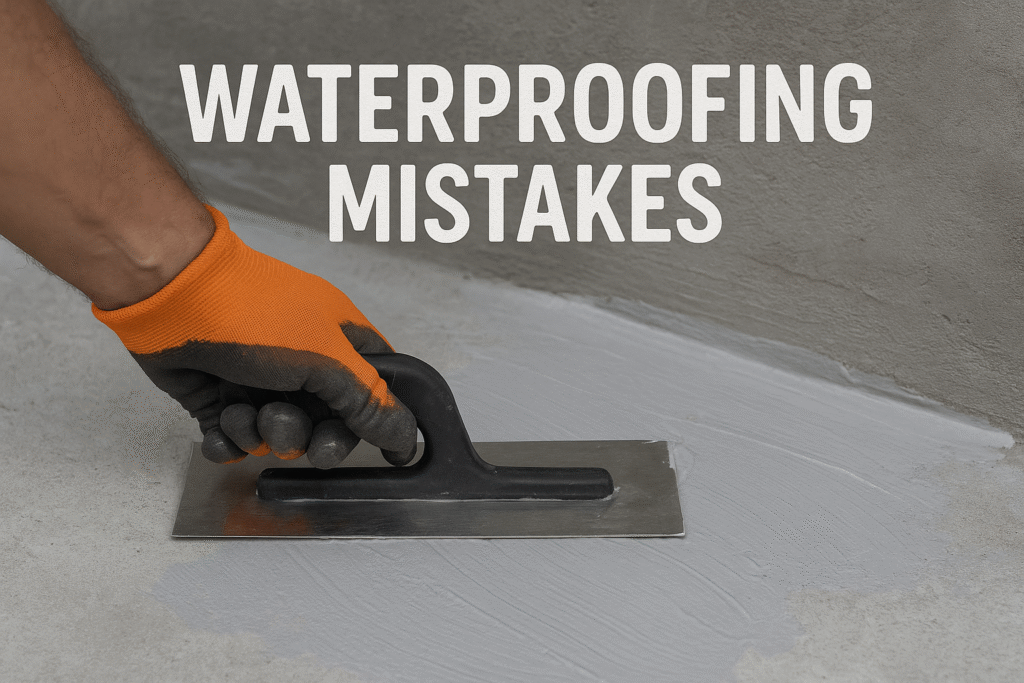
There is something deeply frustrating about finding a water stain on your ceiling or wall, especially after you have invested so much into your home or building. It feels like the structure is betraying you, leaking, peeling, or worse, weakening right under your nose. And in a place like the UAE, where the combination of scorching heat, sudden downpours, and salty air puts the buildings through a real test, waterproofing isn’t just a nice-to-have- it is essential.
However, what most people don’t realize is that waterproofing isn’t just about applying a sealant or membrane. It’s a meticulous process that requires the right products, methods, and professionals. Unfortunately, many homeowners, contractors, or even facility managers unknowingly fall into traps that compromise the entire waterproofing job. These common mistakes lead to issues that could have been avoided with a little guidance and the right partner.
So, let’s walk through the most frequent waterproofing blunders and talk about how you can avoid them. Because protecting your home or building should feel empowering, not overwhelming. And if you ever feel lost, we at White Metal are here to help with expert solutions as one of the top waterproofing companies in the UAE.
Skipping Proper Surface Preparation
What goes wrong: Many times, waterproofing materials don’t adhere properly because the surface they are applied to is dirty, dusty, or already damaged. Think of it like painting on a greasy wall; no matter how good the paint is, it won’t stick.
What to do instead:
• Clean the surface thoroughly, scrub or pressure wash as needed.
• Remove any old coatings or loose material.
• Fix cracks or rough patches beforehand.
• Let the area dry completely before applying anything.
This step might seem basic, but it sets the foundation for everything else. No shortcuts here.
Choose The Wrong Waterproofing Method For The Area
What goes wrong: Different parts of your home or building face different types of stress. Using a kind of waterproofing everywhere can lead to cracks, leaks, and premature failure.
What to do instead:
• Roofs and terraces? Go for liquid-applied or bituminous membranes—they can handle the heat and UV exposure.
• Bathrooms, kitchens, or laundry rooms? Use cementitious or polyurethane coatings.
• Basements or underground structures? Crystalline systems or sheet membranes are the most effective.
Don’t guess—let experts like White Metal, one of the leading waterproofing companies in UAE, guide you in selecting the best option for each space.
Thinking Waterproofing Is A One-Time Job
What goes wrong: People often assume waterproofing is a ‘set it and forget it’ deal. Unfortunately, that’s how small leaks turn into big repairs.
What to do instead:
• Schedule yearly inspections, especially before and after the rainy season.
• Reapply coatings or sealants as needed—especially in high-traffic or exposed areas.
• Keep your drainage system clean and functional.
A little attention each year can save you from a lot of regret (and expenses) later.
Using Materials That Don’t Flex With The Building
What goes wrong: Buildings expand, contract, and shift slightly over time due to temperature and settling. If your waterproofing layer can’t move with it, it will eventually crack.
What to do instead:
• Use flexible membranes like polyurethane in areas that experience structural movement.
• Install expansion joints properly.
• Follow proper curing times to ensure the material sets correctly.
Not Following Manufacturer Instructions
What goes wrong: Improper mixing, incorrect thickness, or rushing through application can ruin even the best materials.
What to do instead:
• Read and follow instructions religiously.
• Use primers when recommended.
• Avoid applying in extremely hot or cold conditions.
Overlooking Small But Critical Details
What goes wrong: Leaks don’t always start in the middle of a wall. They sneak in through the edges around pipes, drains, or corners that weren’t sealed correctly.
What to do instead:
• Pay extra attention to terminations and joints.
• Use sealant tapes, gaskets, and reinforcement mesh around tricky areas.
• Ensure proper slope so that water drains away naturally.
Misunderstanding Tile Grout
What goes wrong: There’s a common myth that tiles and grout are waterproof. They’re not. Regular grout absorbs water, which eventually seeps through.
What to do instead:
• Use epoxy grout in wet areas.
• Always apply a waterproofing layer beneath tiles.
• Re-seal grout lines regularly.
Conclusion
Waterproofing may not be the most glamorous part of property maintenance, but it’s one of the most important. A leaky basement or a peeling ceiling is more than just an eyesore; it’s a sign that water is slowly eating away at your structure. When done right, waterproofing adds years to your building’s life, maintains its value, and gives you peace of mind. When done wrong or neglected altogether, it leads to massive repair costs, mold issues, and structural damage.
That’s why working with professionals who understand the local conditions, materials, and technologies is key. Need expert help? Contact us today.


